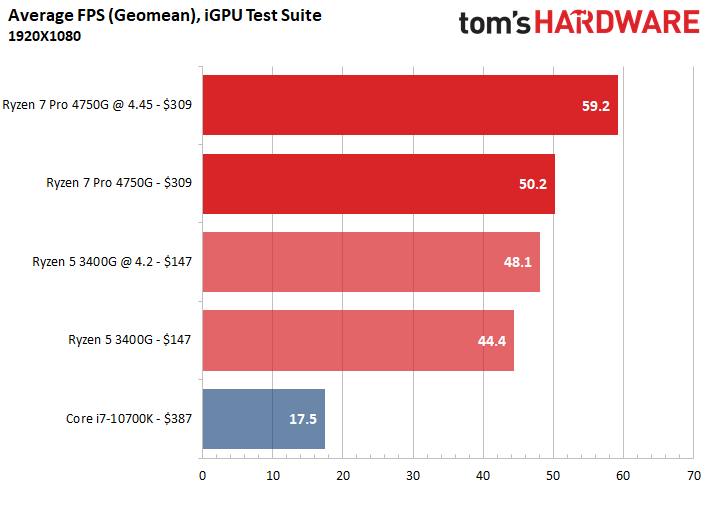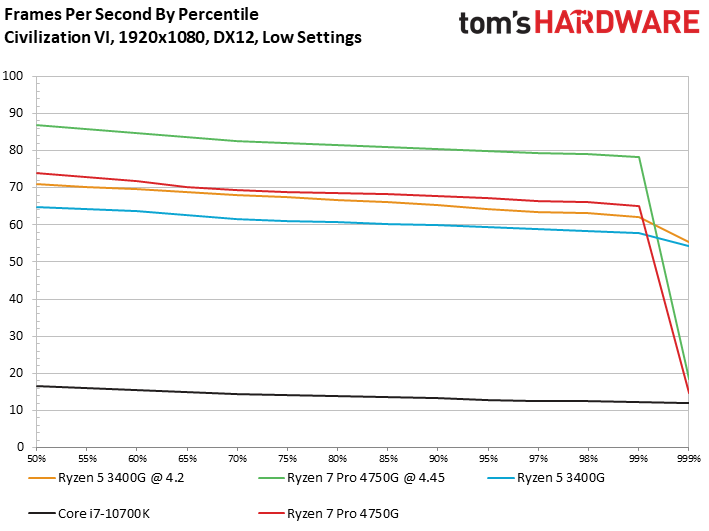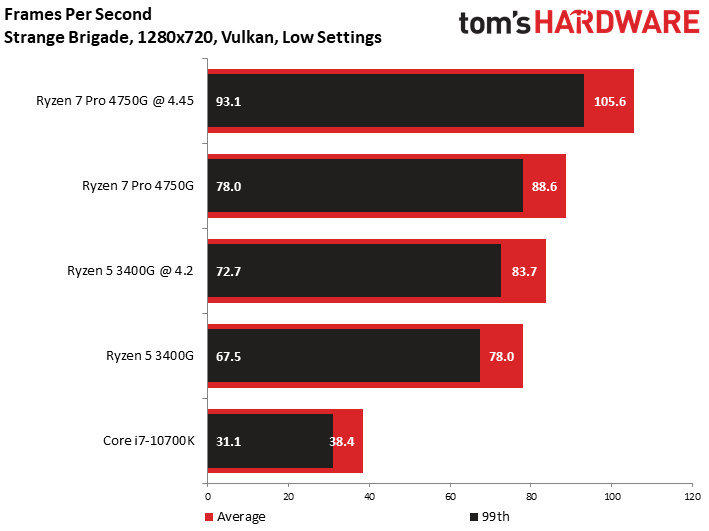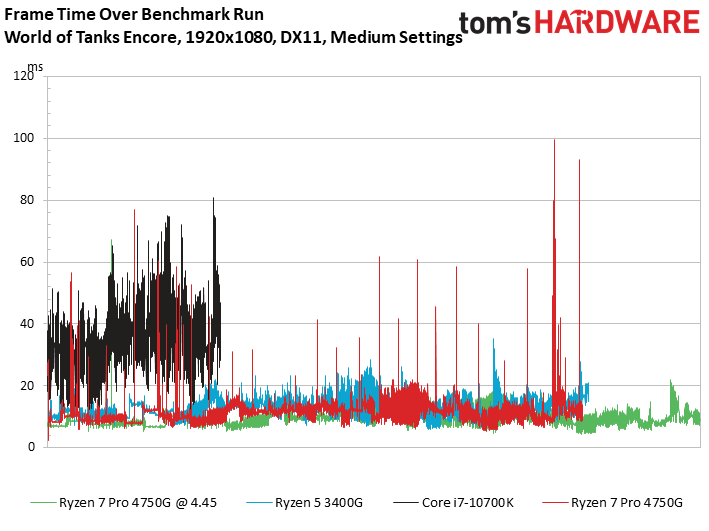Why you can trust Tom's Hardware
The TLDR




The charts above outline the geometric mean of our suite of integrated graphics tests at both 1920x1080 (FHD) and 1280x720 resolutions. Here we're testing with the RX Vega graphics on the Ryzen 7 4750G and Ryzen 5 3400G against the UHD Graphics 630 engine onboard the Core i7-10700K.
We subbed in the 10700K for these tests because even though the 4750G competes with the non-K 10700, we only have the graphics-less 10700F for comparison (we use the 10700F in the remainder of our tests on the following pages).
The Core i7-10700K is faster and falls into a higher price bracket than the 10700, but that's hardly an advantage: The Ryzen 7 4750G provides roughly three times as much performance with the tested FHD and 1280x720 games, and that's at stock settings. After overclocking the 4750G's CPU to 4.45 GHz, the memory to DDR4-4000, and the iGPU to 2400 MHz, Renoir stretches that advantage to roughly 3.5X.
However, the 4750G's gains against the previous-gen Ryzen 5 3400G aren't as pronounced, but they are impressive given that the Renoir chips has three fewer CUs. The 4750G's Vega graphics enjoy improved clock rates and higher memory throughput than the 3400G, yielding 13% more performance with FHD and roughly ~2.5% more performance at 1280x720 (stock settings).
As a general statement, the stock Ryzen 7 4750G basically provides a bit more performance than the overclocked Ryzen 5 3400G, but the gap widens when we compare the two chips with overclocked settings. The tuned 4750G beats the OC'd 3400G by 23% at the FHD resolution, and by 20% at 1280x720. That's a nice step forward if you're willing to invest in the components, like a capable cooler and memory kit, though that could be a bit pricey for this class of chip. Memory bandwidth still appears the be the limiting factor in our tests, but its noteworthy that higher memory overclocks do tend to reach a diminishing point of returns.
Civilization VI on AMD Ryzen 7 Pro 4750G iGPU






The following albums contain test results of both FHD and 1280X720 resolutions (except for World of Tanks). Both of our Ryzen 7 Pro 4750G configurations suffered from a few outliers during the Civilization VI benchmark, which registers as spikes in our frame rate chart and reduced 99.9th percentile frame rates. These spikes weren't noticeable during the benchmark, and the less-granular 99th percentile measurements are slightly better than the Ryzen 5 3400G. Overclocking is a real boon for the 4750G - here we can see it take a substantial lead after tuning.
Far Cry 5 on AMD Ryzen 7 Pro 4750G iGPU






We encountered a few interesting results with the Ryzen 7 Pro 4750G during the Far Cry 5 benchmark. As you can see in the FHD results, the stock 4750G provides lower 99th percentile frame rates than the overclocked 3400G, and that same trend persisted after overclocking. We re-ran these tests multiple times, even dialing back the overclocked iGPU, but encountered identical results. This could be the result of a driver or unoptimized game engine, but the results aren't devastating to performance - the chip is still much faster overall than the 3400G and beats the 10700K by leaps and bounds. In fact, through some portions of this test, the 10700K is like watching a slideshow.
Get Tom's Hardware's best news and in-depth reviews, straight to your inbox.
Shadow of the Tomb Raider on Ryzen 7 Pro 4750G iGPU






The Ryzen 7 Pro 4750G again tops the charts in this title as it delivers a fast, smooth gaming experience. We continue to see a few outliers in our very-granular 99.9th percentile measurements (last two slides), but these don't seem problematic during gameplay. We suspect that driver optimizations could iron out these wrinkles.
Strange Brigade on Ryzen 7 Pro 4750G iGPU






World of Tanks: Encore on Ryzen 7 Pro 4750G iGPU



The World of Tanks Encore benchmark finds the Ryzen 7 4750G capping our integrated graphics benchmark with much the same trend we've seen throughout our tests: At stock settings, the 4750G performs much like the overclocked Ryzen 5 3400G, but separates itself from the pack after overclocking.
Overall the Ryzen 7 4750G is at least a decent step forward over the Ryzen 5 3400G, but we don't see the types of improvements that could be had with a new graphics architecture, and the graphics engine is obviously hampered by memory throughput.
However, the chip does support passable 1080p framerates for the most budget of gaming systems, but you'll have to use lowered quality settings and a narrower cross-section of games, all of which are expected in this price class.
Current page: AMD Ryzen 7 Pro 4750G Integrated Vega Graphics Gaming Benchmarks
Prev Page AMD Ryzen 7 4750G Boost, Thermals, Overclocking, Power Consumption Next Page AMD Ryzen 7 Pro 4750G Discrete GPU Gaming Benchmarks
Paul Alcorn is the Editor-in-Chief for Tom's Hardware US. He also writes news and reviews on CPUs, storage, and enterprise hardware.
-
mdd1963 I expected /hoped for a bit more than bumping FPS in games up only 10-15% compared to the 3400G.... (Apparently I will not be happy until they can match GTX1060-level of performance into the APU)Reply -
neojack impressive results ! this APU is more powerfull than my 2700x in raw power, AND has an igpu about equal to a gtx 1050Reply -
JarredWaltonGPU Reply
It's a bit weird, because the memory bandwidth is lower but all system RAM can be treated as shared VRAM, so you can sometimes run higher settings with less performance problems on in integrated Vega 8 GPU than on a dedicated GPU. But in general, Vega 8 for Renoir is roughly equal to an RX 560, which is basically equal to a GTX 1050.Gurg said:Curious as to which discrete GPU the iGPU is the equivalent.
In a lot of cases, the 1050 is still 25% faster, though. For example, Far Cry 5 1080p normal settings, I got 43 fps, Shadow of the Tomb Raider 1080p Medium I got 39 fps, and Strange Brigade 1080p medium I got 72 fps. That means the GTX 1050 beat the integrated 4750G's Vega 8 Graphics, even when the latter was overclocked. And the GTX 1050 is a pretty slow GPU by today's standards -- the GTX 1650 Super is over twice as fast as the GTX 1050. -
Gurg Reply
Thanks for the reply. It seems like a CPU/iGPU for a $1,000 laptop without a discrete GPU.JarredWaltonGPU said:It's a bit weird, because the memory bandwidth is lower but all system RAM can be treated as shared VRAM, so you can sometimes run higher settings with less performance problems on in integrated Vega 8 GPU than on a dedicated GPU. But in general, Vega 8 for Renoir is roughly equal to an RX 560, which is basically equal to a GTX 1050.
In a lot of cases, the 1050 is still 25% faster, though. For example, Far Cry 5 1080p normal settings, I got 43 fps, Shadow of the Tomb Raider 1080p Medium I got 39 fps, and Strange Brigade 1080p medium I got 72 fps. That means the GTX 1050 beat the integrated 4750G's Vega 8 Graphics, even when the latter was overclocked. And the GTX 1050 is a pretty slow GPU by today's standards -- the GTX 1650 Super is over twice as fast as the GTX 1050. -
Neilbob Replynofanneeded said:"Useless"
no 4th GEN PCIe means no one will buy it.
I agree. This is why Intel is unable to sell a single CPU! A computer without 4th GEN PCIe capability might as well be a brick, right?
(Sarcasm, just in case there's doubt) -
nofanneeded ReplyNeilbob said:I agree. This is why Intel is unable to sell a single CPU! A computer without 4th GEN PCIe capability might as well be a brick, right?
(Sarcasm, just in case there's doubt)
At least intel offers 16 lanes with their CPU . This chips only offers 8 lanes Gen3 .. useless. -
Neilbob Replynofanneeded said:At least intel offers 16 lanes with their CPU . This chips only offers 8 lanes Gen3 .. useless.
I would say 'limiting' rather than useless. Especially seeing as these APUs are intended for an OEM market that in all likelihood won't be pairing them with anything more than a mid-range GPU (that's what the Ryzen 3000 series is for).
Who's to say that more lanes won't be exposed if/when AMD release these for the DIY user base?
Of course, this is just pure speculation from me. Already got my 3600 so I'm all set either way (y)
Edit: So there actually are 16 lanes (which I missed in the review) so above posts turn out to be irrelevant.